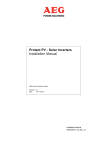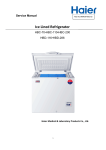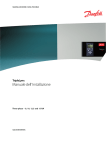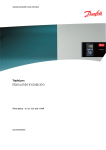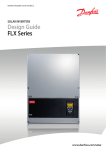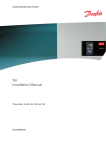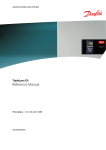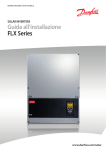Download Danfoss TripleLynx CN Installation manual
Transcript
MAKING MODERN LIVING POSSIBLE TripleLynx CN Installation Manual Three-phase – 10, 12.5 and 15 kW SOLAR INVERTERS Contents Contents 1. Safety and Conformity 2 Important Safety Information 2 Hazards of PV Systems 3 PV Load Switch 3 Conformity 4 2. Introduction 5 Introduction 5 Installation Sequence 6 Overview of Inverter 7 3. Installation 8 Installation Dimensions and Patterns 8 Mounting the Inverter 10 Removing the Inverter 12 Opening and Closing the Inverter 12 AC Grid Connection 14 PV Connection 16 Auxiliary Input/Output 17 4. Start-up and Check of Settings 18 Start-up and Check of Settings 18 Troubleshooting 21 Master Mode 21 5. Technical Data 23 Technical Data 23 Norms and Standards 24 Installation 24 Cable Requirements 25 Torque Specifications for Installation 27 Auxiliary Interface Specifications 28 Network Topology 31 L00410580-01_02 1 1. Safety and Conformity 1 1. Safety and Conformity 1.1. Important Safety Information All persons installing and servicing inverters must be: • Trained and experienced in general safety rules for work on electrical equipment • Familiar with local requirements, rules and regulations for the installation Safety information important for human safety. Violation of warnings may result in injury to persons or death. Information important for the protection of property. Violation of this type of information may cause damage and loss of property. Note: Useful additional information or “Tips and Tricks” on specific subjects. Read this before installing, operating or maintaining the inverter. 2 L00410580-01_02 1. Safety and Conformity Before installation: Check for damage to inverter and packaging. If in doubt, contact the supplier before installing the inverter. Installation: For optimum safety, follow the steps described in this manual. Keep in mind that the inverter has two voltage carrying sides; the PV input and the AC grid. Disconnecting the inverter: Before starting work on the inverter, switch off AC grid at the mains switch and PV using the PV load switch. Ensure that the device cannot be unintentionally reconnected. Use a voltage tester to ensure that the unit is disconnected and voltage free. The inverter can still be charged with very high voltage at hazardous levels even when it is disconnected from grid/mains and solar modules. Wait at least 30 min. following disconnection from grid and PV panels before proceeding. Maintenance and modification: Only authorised personnel are allowed to repair or modify the inverter. To ensure optimum personal safety, only original spare parts available from the supplier should be used. If non-original spare parts are used, the compliance with CE guidelines in respect of electrical safety, EMC and machine safety is not guaranteed. Also observe the danger of burn injury. The temperature of the cooling racks and components inside the inverter may exceed 70ºC. Functional safety parameters: Never change the parameters of the inverter without authorisation from the local energy supply company and instructions from Danfoss. Unauthorised changes of functional safety parameters may cause injury or accidents to people or inverter. Additionally it will lead to the cancellation of all inverter operating approval certificates. The Danfoss inverters are all designed according to the German VDE0126-1-1 (February 2006) standard, which includes an insulation test between PV array(s) and Earth, and a type B, RCMU according to DIN VDE 0100-712. 1 1.2. Hazards of PV Systems Very high DC voltages are present in the system even when the AC grid is disconnected. Faults or inappropriate use may lead to electric arcing. Do not work on the inverter while it has current connected to it. The short-circuit current of the photovoltaic panels is only slightly higher than the maximum operating current and depends on the level of solar irradiation. 1.3. PV Load Switch The inverter has been equipped with a PV load switch (1) for safe disconnection of DC current. Illustration 1.1: TripleLynx CN PV Load Switch L00410580-01_02 3 1. Safety and Conformity 1 1.4. Conformity For approvals and certification information, go to the download area at • www.danfoss.com/solar, Approvals and Certifications • www.danfoss.cn/solar CGC marking - This certifies the conformity of the equipment with the regulations which apply in accordance with China General Certification Center, CGC/GF004:2011. 4 L00410580-01_02 2. Introduction 2. Introduction 2 2.1. Introduction This manual explains the installation and setup of the TripleLynx CN solar inverter, for the installation technician. The inverter display and Web Server are available in Chinese language only. In the manual, English texts appearing in the screenshots and menus are shown for guidance only. Illustration 2.1: TripleLynx CN 8 kW, 10 kW, 12.5 kW, 15 kW The TLX TLX TLX TLX TripleLynx CN inverter series comprises: CN CN+ CN Pro CN Pro+ Common features of the TripleLynx CN variants: • Output rating of 8 kW, 10 kW, 12.5 kW or 15 kW • IP 54 enclosure • PV load switch • MC4 connectors • Manual access via the local display, for inverter configuration Additionally, the TLX CN Pro and TLX CN Pro+ variants provide: • Local and web server access for inverter configuration • Ancillary service functionalities. Refer to the chapter Ancillary Services for details. L00410580-01_02 5 2. Introduction Product Label The product label on the side of the inverter shows: 2 • Inverter type • Important specifications • Serial number, see (1), for identification by Danfoss Illustration 2.2: Product Label 2.1.1. Installation Sequence 6 1. Read the installation manual. Pay special attention to the section Important Safety Information. 2. Install the inverter according to the section Installation Dimensions and Patterns and the section Mounting the Inverter. 3. Open the inverter according to the section Opening and Closing the Inverter. 4. Install AC according to the section AC Grid Connection. 5. Install PV. Remember to use the terminal block to establish parallel connection (if required), as described in the section PV Connection. The inverter has auto-detection. 6. Install Auxiliary input according to the section Connection of Peripheral Units. 7. Close the inverter according to the section Opening and Closing the Inverter. 8. Turn on AC at the mains switch. 9. Set language, time, date, installed PV power and country: - For setup via the integrated Web Server, see the TripleLynx CN User Manual, Web Server Quick Guide section - For setup via the display, see the section Start-up and Check of Settings in this manual. 10. Turn on PV by turning the PV load switch on. 11. Verify the installation by comparing with the auto-detection result in the display, as described in the section PV Connection. 12. The inverter is now ready for operation. L00410580-01_02 2. Introduction 2.1.2. Overview of Inverter 2 Illustration 2.3: Overview of Danfoss TLX CN inverter Live Part 1. AC Connection Area 2. DC Connection Area 3. Terminal block for parallel connection 4. Auxiliary output: Potential free relay PELV (Safe to touch) 5. Auxiliary interface: RS485 6. Auxiliary interface: Temperature, Irradiation, Energy meter (SO) 7. Auxiliary interface: Ethernet Other 8. DC-switch The TLX CN Pro and TLX CN Pro+ variants can also be configured via the Web Server. For further information refer to the Web Server User Manual. L00410580-01_02 7 3. Installation 3. Installation 3.1. Installation Dimensions and Patterns 3 Note: When choosing the installation place, ensure that all labels are visible at all times. For details refer to the section Specifications. Avoid constant stream of water. Avoid direct sunlight. Ensure adequate air flow. Ensure adequate air flow. Mount on non-flammable surface. Mount upright on vertical surface. Prevent dust and ammonia gases. 8 L00410580-01_02 3. Installation 3 Illustration 3.1: Safe Distances Observe these distances when installing one or more inverters. One row mounting is recommended. Contact the supplier for information on mounting in more rows. Illustration 3.2: Wall Plate Note: Use of the wall plate delivered with the inverter is mandatory. Use screws that can safely carry the weight of the inverter. The inverter must be aligned and it is important that the inverter is accessible at the front to allow room for servicing. L00410580-01_02 9 3. Installation 3.2. Mounting the Inverter For safe handling of the inverter, two people must carry the unit, or a suitable transport trolley must be used. Safety boots must be worn. 3 Tilt the inverter as shown in the illustration and place the top of the inverter against the mounting bracket. Use the two guides (1) at the top plate to control the inverter horizontally. Illustration 3.3: Position the Inverter Lift the inverter upwards (2) over the top of the mounting plate until the inverter tilts towards the wall (3). Illustration 3.4: Secure the inverter 10 L00410580-01_02 3. Installation Place the lower part of the inverter against the mounting bracket. 3 Illustration 3.5: Place Inverter in Mounting Bracket Lower (4) the inverter and make sure that the hook of the inverter base plate is placed in the lower part of the mounting bracket (5). Check that it is not possible to lift the bottom of the inverter away from the mounting bracket. (6) Fasten the screws on either side of the wall plate to secure the inverter. Illustration 3.6: Fasten screws L00410580-01_02 11 3. Installation 3.3. Removing the Inverter Loosen the locking screws on either side of the inverter. Removal is performed in the reverse order of mounting. With a firm grip at the lower end of the inverter, lift the inverter approximately 20 mm vertically. Pull the inverter slightly away from the wall. Push upwards at an angle until the wall plate releases the inverter. Lift the inverter away from the wall plate. 3 3.4. Opening and Closing the Inverter Remember to observe all ESD safety regulations. Any electrostatic charge must be discharged by touching the grounded housing before handling any electronic component. Use a TX 30 screwdriver to loosen the two front screws. Turn the screwdriver until the screws pop up. Screws are secured with a spring and cannot fall out. Illustration 3.7: Loosen Front Screws 12 L00410580-01_02 3. Installation Push the front cover upwards. When a slight resistance is felt, give the front cover a tap on the bottom to snap it into holding position. It is recommended to use the holding position instead of dismounting the front cover completely. 3 Illustration 3.8: Open the Inverter To close the inverter, hold on to the lower end of the front cover with one hand and give it a tap on the top until it falls into place. Guide the front cover into place and fasten the two front screws. Illustration 3.9: Close the Inverter L00410580-01_02 13 3. Installation 3 Illustration 3.10: Fasten Front Screws and Ensure Proper PE Connection The two front screws are the PE connection to the front cover. Make sure that both screws are mounted and fastened with the specified torque. 3.5. AC Grid Connection Note: When choosing the installation place, ensure that all labels are visible at all times. For details refer to the section Specifications. 14 L00410580-01_02 3. Installation 3 Illustration 3.11: AC Cable Wire Strip Legend 1 Blue cable - Neutral 2 Yellow/green cable - Earth The illustration shows the stripping of insulation of all 5 wires of the AC cable. The length of the PE wire must be longer than the mains and neutral wires. Illustration 3.12: AC Connection Area 1. Verify the inverter matches the grid-voltage. 2. Release main circuit breaker and make precautions to prevent reconnection. 3. Open the front cover. 4. Insert the cable through the AC gland to the terminal blocks. 5. The three mains wires (L1, L2, L3) and the Neutral wire (N) are mandatory and must be connected to the 4-pole terminal block with the respective markings. 6. The Protective Earth wire (PE) is mandatory and must be connected directly to the chassis PE terminal. Insert the wire and fasten the screw to secure the wire. 7. All wires must be properly fastened with the correct torque. See the section Technical Data, Torque Specifications for Installation. L00410580-01_02 15 3. Installation 8. Close the front cover, and remember to verify that both front screws are applied with the correct torque to obtain PE connection. 9. Close main circuit breaker. For safety, check all wiring. Connecting a phase wire to the neutral terminal may permanently damage the inverter. Do not remove the short circuit bridge at (1). 3 3.6. PV Connection Note: When choosing the installation place, ensure that all labels are visible at all times. For details refer to the section Specifications. Do NOT connect PV to earth! Use a suitable voltmeter that can measure up to 1000 V DC. 1. First verify the polarity and maximum voltage of the PV arrays by measuring the PV open circuit voltage.The PV open circuit voltage must not exceed 1000 V DC. 2. Measure the DC voltage between the plus-terminal of the PV array and Earth (or the green/yellow PE cable). The voltage measured should approximate zero. If the voltage is constant and not zero there is an insulation failure somewhere in the PV array. 3. Locate and fix the failure before continuing. 4. Repeat this procedure for all arrays. It is allowed to distribute the input power on the inputs unevenly, presuming that: • The nom. PV power of the inverter is not exceeded (8.2 / 10.3 / 12.9 / 15.5 kW). • The individual input is not exceedingly loaded, and not more than 6000 W. • The maximum short circuit current of the PV modules at STC (Standard Test Conditions) must not exceed 12 A per input. On the inverter turn the PV load switch into off position. Connect the PV cables by means of MC4 connectors. Ensure correct polarity! The PV load switch can now be switched on when required. Illustration 3.13: DC Connection Area 16 L00410580-01_02 3. Installation When unmated the MC4 connectors are not IP54. The intrusion of moisture may occur in the following situations: 1. The inverter runs in Master/Slave operation and only one or two PV inputs are in use. In this case, the other inputs are not connected to PV and they are therefore open to intrusion. 2. Not all PV inputs are connected. 3. PV connectors are not fitted; for example in case of disconnection of parts of a PV plant over a longer period of time. 3 In situations where the PV connectors are not fitted, a seal cap must be mounted (included in the scope of the delivery). All inverters with MC4 connections are delivered with seal caps on inputs 2 and 3. During installation, the seal caps of those inputs that are to be used are discarded. Note: The inverter is protected against reversed polarity but it will not generate power until the polarity is corrected. To achieve optimum production, the open circuit voltage (STC) of the PV modules must be lower than the max. input voltage of the inverter (see the specifications), multiplied with a factor of 1.13. UOC, STC x 1.13 ≤ UMAX, inv 3.7. Auxiliary Input/Output Note: When choosing the installation place, ensure that all labels are visible at all times. For details refer to the section Specifications. The inverter has the following auxiliary input/output: • 2 x RJ45 for RS485 • 2 x RJ45 for Ethernet • 1 x 8 pole terminal block for RS485 • 1 x 10 pole terminal block for • - PT1000 temperature sensor input x 3 - Irradiation sensor input - Energy meter (S0) input 1 x 2 pole terminal block for relay outputs Refer to the specifications for an overview of the communication board and to the inverter user manual for details regarding auxiliary input configuration via the display. L00410580-01_02 17 4. Start-up and Check of Settings 4. Start-up and Check of Settings 4.1. Start-up and Check of Settings Note: Due to the advanced functionalities of the inverter, it may take up to 10 seconds before the display becomes available after power up. 4 Note: For the TLX CN Pro version the first start-up and check of settings can also be performed via the integrated Web Server. For further details, refer to the Web Server User Manual. The inverter is shipped with a predefined set of settings for different grids. All grid specific limits are stored in the inverter and must be selected at installation. It is always possible to see the applied grid limits in the display. The inverter accounts for daylight saving automatically. After installation, check all cables and then close the inverter. Turn on AC at the mains switch. When prompted by the display select language. This selection has no influence on the operating parameters of the inverter and is not a grid code selection. The language is set to Chinese at initial start-up. Illustration 4.1: Select Language 18 L00410580-01_02 4. Start-up and Check of Settings Set time as prompted by the display. Press 'OK' to select number. Press ‘ ▲ ’ to scroll up through the numbers. Select by pressing 'OK'. The clock is 24-hour format. 4 Illustration 4.2: Set Time Note: It is very important to set the time and date accurately as the inverter uses this for logging. If a wrong time/date is accidentally set, correct it immediately in the set date and time menu [Setup → Inverter details → Set date and time]. Set date as prompted by the display. Press 'OK' to select. Press ‘ ▲ ’ to scroll up through the numbers. Select by pressing 'OK'. Chinese date format: yyyy-mm-dd. Illustration 4.3: Set Date L00410580-01_02 19 4. Start-up and Check of Settings Enter the amount of installed PV power for each of the PV inputs. When two or more PV inputs are connected in parallel, each PV input in the parallel group must be set to the total amount of PV power installed to that group divided by the number of parallel inputs. See the table below for examples of installed PV power. 4 Illustration 4.4: Installed PV Power The display will now show “Select grid”. The grid code is set to “undefined” at initial startup. To select grid code, press 'OK'. Press ‘ ▼ ’ to scroll down through the list of countries. Select the grid code for the installation by pressing ‘OK’. To meet medium-voltage grid requirements select a grid code ending in MV. It is very important that the correct grid code is chosen. Illustration 4.5: Select Grid Code Confirm the choice by selecting the grid code again and press 'OK’. The settings for the chosen grid code have now been activated. Illustration 4.6: Confirm Grid Code Selection Correct selection of grid code is essential to comply with local and national standards. 20 L00410580-01_02 4. Start-up and Check of Settings Note: If the two grid code selections do not match they will be cancelled and it will be necessary to redo the selections. If an incorrect grid code is accidentally accepted at the first selection, simply accept the “Grid: Undefined” in the confirm grid code screen. This will cancel the country selection and a new selection is possible. If an incorrect grid code is selected twice, call service. The inverter will start automatically if sufficient solar radiation is available. The start-up will take a few minutes. During this period, the inverter will carry out a self-test. 4 “Installed PV power” to be programmed Actual Configuration PV1, PV2 and PV3 are all set into individual mode. The nominal PV power installed are: PV 1: 6000 W PV 2: 6000 W PV 3: 3000 W PV1 and PV2 are set into parallel mode and have a total of 10 kW PV power installed. PV3 is set into individual mode and has nominal 4 kW PV power. PV1 and PV2 are set into parallel mode and have a total of 11 kW PV power installed. PV3 is set to ‘Off’ and has no PV installed. PV PV PV PV PV PV PV PV PV 1: 2: 3: 1: 2: 3: 1: 2: 3: 6000 6000 3000 5000 5000 4000 5500 5500 0W W W W W W W W W Table 4.1: Examples of Installed PV Power 4.2. Troubleshooting For information on Troubleshooting, please see the TLX CN Reference Manual. 4.3. Master Mode The TLX CN Pro and TLX CN Pro+ inverters include a Master Mode feature that allows one inverter to be appointed as Master Inverter. From the web interface of the master inverter, it is possible to access any inverter in the network from one single point using a standard web browser. The Master Inverter can act as a datalogger, collecting data from all inverters in the network. These data can be displayed graphically from the web server of the Master Inverter, or the data can also be uploaded to external webportals or exported directly to a PC. The Master Inverter is also able to replicate settings and data to the other TLX CN Pro and TLX CN Pro+ inverters in the network, enabling easy commissioning and data management of larger networks. Replication can be performed once, prior to defining the grid code in follower inverters. L00410580-01_02 21 4. Start-up and Check of Settings To enable Master mode go to the Inverter details menu [Setup → Inverter details → Master mode] and set Master mode to Enabled. Ensure that no other master inverters are present in the network prior to carrying out this action. When Master mode is enabled, it is possible to initiate a network scan [Setup → Inverter details → Master mode → Network]. This will show all inverters connected to the master inverter. 4 Illustration 4.7: Master Mode 22 L00410580-01_02 5. Technical Data 5. Technical Data 5.1. Technical Data Nomenclature 1) Pac,r Vac,r Iacmax cosphiac,r fr Vdc,r Vmppmin Vmppmax Vdcmax Vdcstart Vdcmin Idcmax Parameter AC Nom. power AC Reactive power range AC voltage range (P-N) Nominal current AC Max. current AC AC current distortion (THD %) Power factor at 100 % load Controlled power factor range “Connecting” power loss Night-time power loss (off grid) Grid frequency DC Nominal power DC Max. recommended PV power at STC 2) Nominal voltage DC MPP voltage - nominal power 3) MPP efficiency Max. DC voltage Turn on voltage DC Turn off voltage DC Max. current DC Max. short circuit current DC at STC Min. on grid power Efficiency Max. efficiency Euro efficiency, V at dc,r Other Dimensions (L,W,H) Mounting recommendation Weight Acoustic noise level4 MPP trackers Operation temperature range Nom. temperature range Storage temperature Overload operation Overvoltage category AC Overvoltage category DC PLA5) Reactive power Functional Safety Safety (protective class) PELV on the communication and control card Islanding detection - loss of mains Voltage magnitude Frequency DC content of AC current Insulation resistance RCMU - Type B Indirect contact protection Short circuit protection TripleLynx CN 8 kW TripleLynx CN 10 kW TripleLynx CN 12.5 kW TripleLynx CN 15 kW 8000 W 0-4.8 kVAr 3 x 230 V ± 20 % 3 x 12 A 3 x 12 A <4% 10000 W 0-6.0 kVAr 3 x 230 V ± 20 % 3 x 15 A 3 x 15 A <5% 12500 W 0-7.5 kVAr 3 x 230 V ± 20 % 3 x 19 A 3 x 19 A <5% 15000 W 0-9.0 kVAr 3 x 230 V ± 20 % 3 x 22 A 3 x 22 A <5% > 0.98 0.8 over-excited 0.8 under-excited 10 W <5W > 0.99 0.8 over-excited 0.8 under-excited 10 W <5W > 0.99 0.8 over-excited 0.8 under-excited 10 W <5W > 0.99 0.8 over-excited 0.8 under-excited 10 W <5W 50 ± 5 Hz 50 ± 5 Hz 50 ± 5 Hz 50 ± 5 Hz 8250 W 9500 Wp 10300 W 11800 Wp 12900 W 14700 Wp 15500 W 17700 Wp 700 V 345-800 V 700 V 430-800 V 700 V 358-800 V 700 V 430-800 V 99.9 % 1000 V 250 V 250 V 2 x 12 A 2 x 12 A 99.9 % 1000 V 250 V 250 V 2 x 12 A 2 x 12 A 99.9 % 1000 V 250 V 250 V 3 x 12 A 3 x 12 A 99.9 % 1000 V 250 V 250 V 3 x 12 A 3 x 12 A 20 W 20 W 20 W 20 W 97.9 % 97.0 % 98 % 97.0 % 98 % 97.3 % 98 % 97.4 % 700 x 525 x 250 mm Wall bracket 35 kg 56 dB(A) 2 -25..60 °C 700 x 525 x 250 mm Wall bracket 35 kg 56 dB(A) 2 -25..60 °C 700 x 525 x 250 mm Wall bracket 35 kg 56 dB(A) 3 -25..60 °C 700 x 525 x 250 mm Wall bracket 35 kg 56 dB(A) 3 -25..60 °C -25..45 °C -25..60 °C Change of operating point Class III Class II Included TLX CN+ and TLX CN Pro+ -25..45 °C -25..60 °C Change of operating point Class III Class II Included TLX CN+ and TLX CN Pro+ -25..45 °C -25..60 °C Change of operating point Class III Class II Included TLX CN+ and TLX CN Pro+ -25..45 °C -25..60 °C Change of operating point Class III Class II Included TLX CN+ and TLX CN Pro+ Class I Class II Class I Class II Class I Class II Class I Class II Three-phase monitoring (ROCOF) Included Included Included Included Included Yes (class I, grounded) Yes Three-phase monitoring (ROCOF) Included Included Included Included Included Yes (class I, grounded) Yes Three-phase monitoring (ROCOF) Included Included Included Included Included Yes (class I, grounded) Yes Three-phase monitoring (ROCOF) Included Included Included Included Included Yes (class I, grounded) Yes 5 Table 5.1: Specifications L00410580-01_02 23 5. Technical Data 1) 2) 3) 4) 5) According to FprEN 50524. For fixed systems with semi-optimal conditions. At identical input voltages. At unequal input voltages, Vmppmin can be as low as 250 V depending on total input power. SPL (Sound Pressure Level) at 1.5m. Grid Management Box (TLX CN Pro and TLX CN Pro+) or third-party product. 5.2. Norms and Standards Refer to Chapter 1, section Conformity for details. 5.3. Installation Parameter Temperature Environmental class according to IEC Specification −25 °C - +60 °C (>45 °C derating) IEC60721-3-3 3K6/3B3/3S3/3M2 Air quality ISA S71.04-1985 Level G2 (at 75 % RH) Coastal, heavy industrial and farmer areas Must be measured and classified acc. to ISA S71.04-1985 Vibration 1G Ingress protection class 54 Max. operating altitude 3000 m above sea level. PELV protection is effective up to 2000 m above sea level only. Installation Avoid constant stream of water. Avoid direct sunlight. Ensure adequate air flow. Mount on non-flammable surface. Mount upright on vertical surface. Prevent dust and ammonia gases. 5 Table 5.2: Conditions for Installation Parameter Wall Plate Condition Hole diameter Alignment Specification 30 x 9 mm Perpendicular ± 5° all angles Table 5.3: Wall Plate Specifications 24 L00410580-01_02 5. Technical Data 5.4. Cable Requirements Cable AC Outer diameter Insulation strip Max. recommended cable length TripleLynx CN 8 kW and 10 kW Max. recommended cable length TripleLynx CN 12.5 kW Condition 5 wire cable All 5 wires 2.5 mm2 4 mm2 6 mm2 10 mm2 4 mm2 6 mm2 10 mm2 6 mm2 10 mm2 Specification Copper 18-25 mm 16 mm 21 m 34 m 52 m 87 m 28 m 41 m 69 m 34 m 59 m Max. recommended cable length TripleLynx CN 15 kW PE Cable diameter at least as phase cables DC Max. 1000 V, 12 A Cable length < 200 m* 4 mm2 - 4.8 Ω /km Cable length >200-300 m* 6 mm2 - 3.4 Ω /km Mating connector Multi-contact PV-ADSP4./PV-ADBP4. * The distance between inverter and PV array and back, plus the summarised length of the cables used for PV array installation. 5 Table 5.4: Cable Requirements Note: Avoid power loss in cables of more than 1 % of nominal inverter rating. Illustration 5.1: TripleLynx CN 8 kW Cable Losses [%] versus Cable Length [m] L00410580-01_02 25 5. Technical Data 5 Illustration 5.2: TripleLynx CN 10 kW Cable Losses [%] versus Cable Length [m] Illustration 5.3: TripleLynx CN 12.5 kW Cable Losses [%] versus Cable Length [m] Illustration 5.4: TripleLynx CN 15 kW Cable Losses [%] versus Cable Length [m] Consider also the following when choosing cable type and cross-sectional area: 26 - Ambient temperature - Layout type (inside wall, under ground, free air etc.) - UV resistance L00410580-01_02 5. Technical Data 5.5. Torque Specifications for Installation 5 Illustration 5.5: Overview of Inverter with Torque Indications, 1-3 Illustration 5.6: Overview of Inverter with Torque Indications, 4-7 1 2 3 4 5 6 7 Parameter Terminal blocks (large) Terminal blocks (small) PE M16 M25 Front screw Locking screw Screwdriver Straight slot 1.0 x 5.5 mm Straight slot 1.0 x 5.5 mm Straight slot 1.0 x 5.5 mm SW 19 mm SW 30 mm TX 30 TX 30 Tightening Torque Min. 1.2 Nm 0.5 Nm 2.2 Nm 2-3 Nm 2-3 Nm 6-8 Nm 5 Nm Table 5.5: Nm Specifications L00410580-01_02 27 5. Technical Data 5.6. Auxiliary Interface Specifications Parameter Serial Communication Common cable specification RJ45 (2 pcs.) connectors Terminal block Parameter Details Cable jacket diameter (⌀) Cable type Cable Characteristic Impedance Max. cable length Wire gauge Cable shield termination Maximum wire gauge Cable shield termination Max. number of inverter nodes Galvanic interface insulation Direct contact protection Double/Reinforced insulation Short circuit protection Communication Star and daisy chain Common cable Max. cable length between inverters Specification Max. number of inverters Cable type Temperature sensor input Cable specification Cable jacket diameter (⌀) Cable type Cable shield termination Maximum wire gauge Maximum resistance per wire Maximum cable length Sensor specification Nominal resistance/temperature coefficient Measurement range Measurement accuracy Direct contact protection Double/Reinforced insulation Short circuit protection Irradiation sensor input Cable specification Cable jacket diameter (⌀) Cable type 5 Sensor Specification Direct contact protection Short circuit protection Energy meter input Cable specification Sensor Input Specification Direct contact protection Short circuit protection -20 oC - +100 oC ±3 % Yes Yes x1 4-8 mm Shielded Single Pair - Number of wires depend on the sensor type used Cable shield termination Via EMC cable clamp Maximum wire gauge 2.5 mm2 Maximum resistance per wire 10 Ω Maximum cable length 30 m Sensor type Passive Measurement accuracy ±5 % (150 mV sensor output voltage) Output voltage of sensor 0-150 mV Max. output impedance (sensor) 500 Ω Input impedance (electronics) 22 kΩ Double/Reinforced insulation Yes Yes S0 input x1 4-8 mm Cable jacket diameter (⌀) Cable type Shielded Single Pair - 2-wire Cable shield termination Via EMC cable clamp Maximum wire gauge 2.5 mm2 Maximum cable length 30 m Sensor input class Class A Nominal output current 12 mA for an 800 Ω load Maximum short circuit output cur- 24.5 mA rent Open circuit output voltage +12 VDC Maximum pulse frequency 16.7 Hz Double/Reinforced insulation Yes Yes Table 5.6: Auxiliary Interface Specifications 28 Specification RS485 2 x 5-7 mm Shielded Twisted Pair (STP) (Cat 5e)2) 100 Ω – 120 Ω 1000 m 24-26 AWG (depending on mating metallic RJ45 plug) Via metallic RJ45 plug 2.5 mm2 Via EMC cable clamp 634) Yes, 500 Vrms Yes Yes Ethernet 100 m (total network length: unlimited) 1001) Shielded Twisted Pair (STP) (Cat 5e)2) 3 x PT1000 3) 4-8 mm Shielded Single Pair - 2-wire Via EMC cable clamp 2.5 mm2 10 Ω 30 m 3.85 Ω/oC L00410580-01_02 5. Technical Data 1) Max. number of inverters are 100. If GSM modem is used for portal upload, the amount of inverters in a network is limited to 50. 2) For outdoor use, we recommend outdoor burial type cable (if buried in the ground) for both Ethernet and RS485. 3) Third input is used for compensation of the irradiation sensor. 4) The number of inverters to be connected in the RS485 network depend on which peripheral device is connected. To ensure fulfilment of IP enclosure rating, correctly mounted cable glands are essential for all peripheral cables. To ensure EMC compliance, shielded cables must be applied for sensor inputs and RS485 communication. Unshielded cables may be applied for alarm outputs. Other auxiliary cables must pass through the designated EMC cable clamps to establish mechanical fixing and in case of shielded cable termination to the shielding device. Parameter Potential free contact Rating AC Rating DC Maximum wire gauge Over voltage category Optional Modem Condition Relay output 5 Specification x1 250 VAC, 6.4 A, 1600 W 24 VDC, 6.4 A, 153 W 2.5 mm2 Class III GSM Table 5.7: Auxiliary Input Specifications Illustration 5.7: Communication Board L00410580-01_02 29 5. Technical Data RS485 Terminate the RS485 communication bus at both ends. To terminate the RS485 bus: • Connect Bias L to RX/TX B • Connect Bias H to RX/TX A The RS485 address of the inverter is unique, and defined at the factory. 5 Illustration 5.8: RS485 Communication Detail - Cat 5 T-568A Pinout RS485 1. GND 2. GND 3. RX/TX A (-) 4. BIAS L 5. BIAS H 6. RX/TX B (+) 7. Not connected 8. Not connected Bold = Compulsory, Cat5 cable contains all 8 wires For Ethernet: 10Base-TX and 100Base-TX auto cross over Table 5.8: RJ45 Pinout Detail for RS485 Ethernet Ethernet connection is available for TLX CN Pro and TLX CN Pro+ variants only. Pinout Ethernet 1. 2. 3. 4. 5. 6. 7. 8. RX+ RX TX+ TX- Colour Standard Cat 5 T-568A Green/white Green Orange/white Blue Blue/white Orange Brown/white Brown Table 5.9: RJ45 Pinout Detail for Ethernet 30 L00410580-01_02 Cat 5 T-568B Orange/white Orange Green/white Blue Blue/white Green Brown/white Brown 5. Technical Data 5.6.1. Network Topology The inverter has two Ethernet RJ45 connectors enabling the connection of several inverters in a line topology as an alternative to the typical star topology. The two ports are similar and may be used interchangeably. For RS485, only linear daisy chain connections can be used. Note: Ring topology is not allowed. 5 Illustration 5.9: Network Topology 1 2 3 (4) Linear Daisy Chain Star Topology Ring Topology (not allowed) (Ethernet Switch) Note: The two network types cannot be mixed. The inverters can only be connected in networks which are either solely RS485 or solely Ethernet. Note: Ethernet connection is recommended for faster communication. RS485 connection is required when a web logger or data logger is connected to the inverter. L00410580-01_02 31 Danfoss Solar Inverters A/S Ulsnaes 1 DK-6300 Graasten Denmark Tel: +45 7488 1300 Fax: +45 7488 1301 E-mail: [email protected] www.solar-inverters.danfoss.com Danfoss (Shanghai) Automatic Controls Co., Ltd. 20th, Floor, Block C, Hi-Tech Building 900 Yi Shan Road Shanghai 200233, P.R.China Tel: +86 (21) 61513000 Fax: +86 (21) 61513100 www.danfoss.com.cn 丹佛斯(上海)自动控制有限公司 上海市宜山路900号科技大楼C楼20层 电话:+86 (21) 61513000 传真:+86 (21) 61513100 www.danfoss.com.cn Rev. date 2011-11-16 Lit. No. L00410580-01_02

































